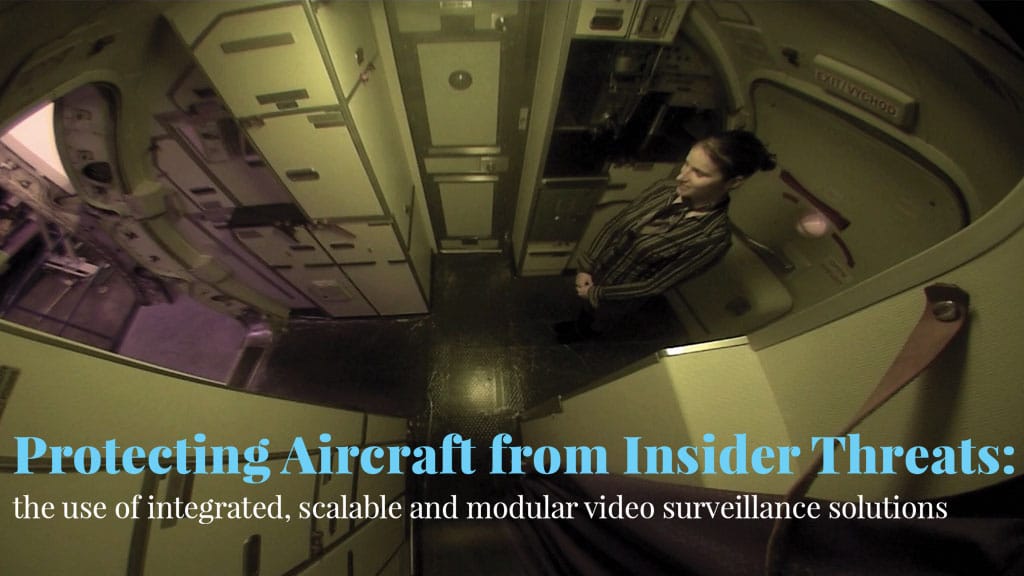In these modern times, passengers have grown accustomed to being under video surveillance for a large proportion of their day and expect to be under surveillance from the time they enter the airport until they leave. It would probably surprise them to know that when inside the aircraft they are no longer under the security net of video cameras. In terms of the insider threat, the deployment of video surveillance on board aircraft would provide significant opportunities to deter and detect criminal activity. Mike Horne gives us some explanations.
Experienced aircraft-based video vendors have designed and developed modern networked closed-circuit television (CCTV) camera solutions. Several larger original equipment manufacturers (OEMs) have shown interest, and they are starting to appear on commercial airlines worldwide. The cameras can be placed anywhere within the passenger cabin, in the cargo area, in accessible avionics bay areas, or on the outside of the aircraft to monitor loading and unloading operations and passenger movement.
“…covert cameras were placed in the cargo bay set to record whenever the cargo doors were open…”
Connected through a dedicated high-speed ethernet network using fibre optics, various high-resolution cameras, monitors and digital video recorders can easily be identified by their location, and a system can be customised to suit individual threats and airline needs. Useful information such as time, tail number, and location can be recorded with the video data, and triggers may be set either using video analysis or a simple event button to start and stop recording, or to simply add a marker allowing for easier analysis and replay of video clips that may be of interest.
Specific airline needs recently addressed by CCTV solutions include the following:
a) An airline was experiencing reports of theft from passenger bags. Covert cameras were placed in the cargo bay set to record whenever the cargo doors were open. The cameras were not viewed in real-time, or on-board the aircraft at all, but recordings were regularly downloaded and reviewed by security staff at the airline’s head office. Four times the number of reported thefts were detected and the ground staff involved were dealt with. This led to a reduction in losses and a far better response to passenger complaints.
b) An airline was concerned by the levels of air rage being reported on flights and was worried about their ‘duty of care’ to their flight crews. Cameras were placed throughout the passenger cabin, with monitors in forward and rear galleys. A small recorder was placed in the avionics bay, with an event button to start recording located next to the flight attendants’ monitors. Recordings could be used for prosecution, but the simple presence of a camera system was enough to substantially reduce levels of unruly passenger behaviour.
c) A cargo airline was experiencing high costs for manually checking freight holds for stowaways before each flight. A camera system including sophisticated motion detection algorithms and infrared lighting was installed on the freighter and the pictures were viewed in real time by the flight crew, enabling a check without entering the cargo area.
d) An airline was trying to reduce its insurance costs by preventing damage to aircraft from collisions with ground vehicles during loading and unloading operations. Video recordings of ground-based operations from external cameras were enough to catch the handlers responsible, and for the airline to reduce their liability.
e) An airline was experiencing theft and damage to the aircraft interior while waiting unattended at the gate. It was not clear whether cleaning staff were responsible, or whether non-authorised personnel were gaining entry to the gate area. A system of on-board cameras connected to a Wi-Fi transmitter at the gate and a digital video recorder allowed quick and easy recognition and resolution of the problem, by an office-based security team. Through standard internet connections this team could be located anywhere.
Since 9/11, security cameras around the flight deck door have become commonplace and extending that system to cover the remainder of the aircraft is the next logical step in improving security throughout the airline industry. Next would be the eventual integration of cameras into the flight deck, with recordings saved on a crash-protected recorder.
Integrated cabin surveillance systems are now being proposed by OEMs in their newly developed aircraft to address airlines’ needs. It is inevitable that the use of these systems will continue to grow, and that passengers will gain an increased sense of security.

Mike Horne is a UK-based business development manager for Latécoère and has worked in video on aircraft since 1997.
